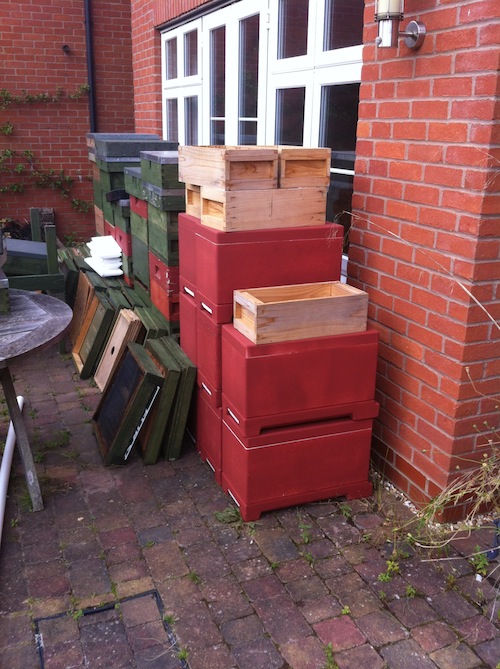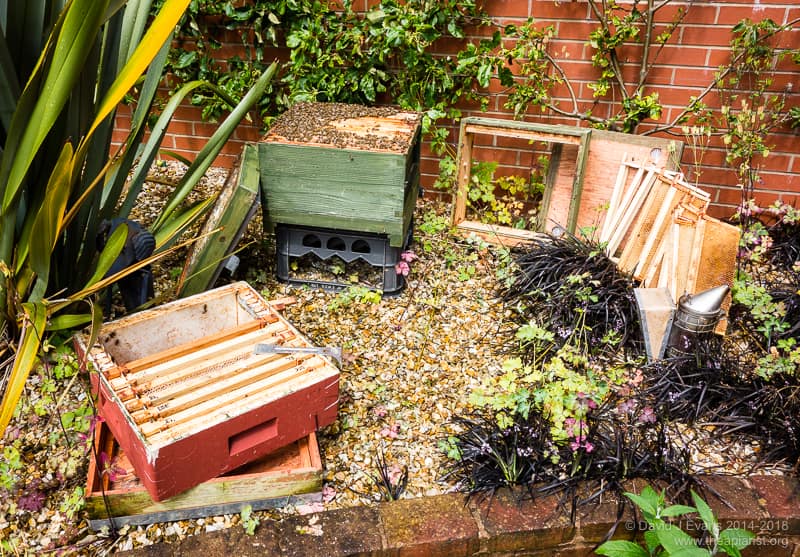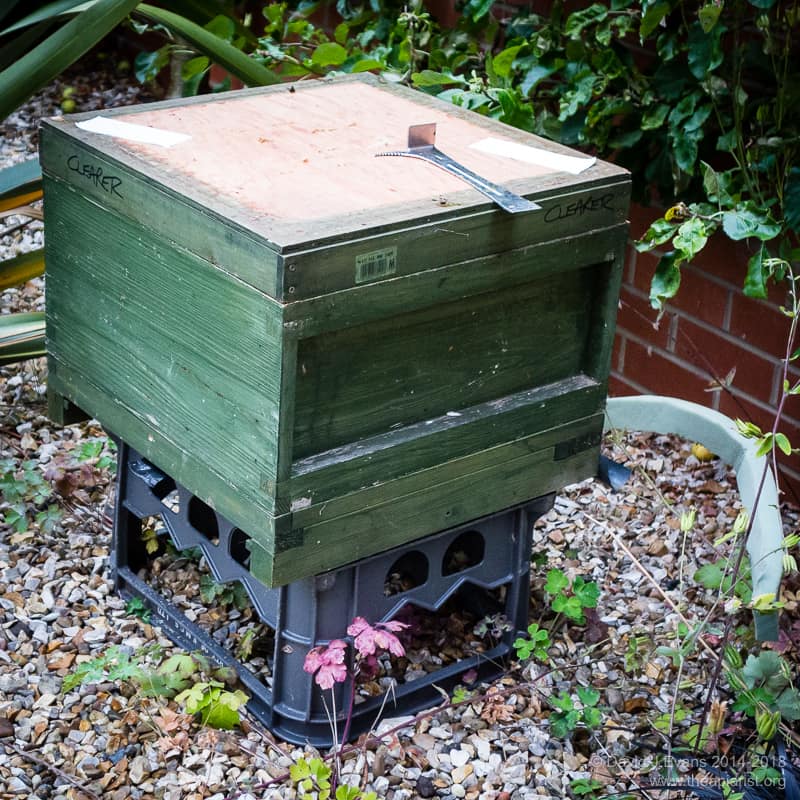Late arrivals

Stacked boxes …
I’m moving house in a couple of weeks and so stacked unused ‘bee equipment’ in a pile on the patio for packing. Some of the supers contained drawn comb from previous years, some of the broods were empty and some contained prepared foundationless frames. I thought I’d taken care to align everything reasonably well to ensure they were ‘beetight‘ when I finished up late on Thursday evening. However, I’d misaligned a chest high stack in the middle and unknowingly left a finger-width crack which allowed some scouts to decide it was a desirable site. Sometime mid-morning on Friday – when I was in the office – a good sized swarm arrived. I hadn’t noticed any scouts checking out the location. I originally thought it was robbers cleaning out honey from the supers, but a quick peek under the roof (there was no crownboard on the stack) showed they were busy drawing comb. Going by the numbers of bees present it looked like a prime swarm, but you can’t be sure unless you find the laying queen.
They couldn’t have chosen a much less suitable (for me … it obviously suited them 😉 ) stack to set up home in. The bottom three boxes were empty broods, topped with three supers, two of which were part filled with drawn drone foundation. Inevitably the spacing of the frames in the supers was all over the place. Removing the roof gently showed they were already building brace comb, attached to the roof and/or the frames. The bees were accessing the stack somewhere in the middle, on the face against the wall. What a mess.

Rearranging the hive …
I fired up the smoker and got kitted up. It was relatively easy to split the stack and put a temporary floor below the supers (with the entrance facing the wall) and put a crownboard in place. The colony were agitated but not aggressive. There were far too many bees to try and find the queen. It was a hot day and there was a whirling maelstrom of bees. I was concerned that the queen – if she was mated – would start laying up the drawn drone foundation in the supers. By evening the stack was quietly humming away, with all the bees inside, so I moved them a few feet away to a purpose-built stand (the ubiquitous milk crate) … swarms can be relocated within 24-48 hours of arrival during which time the “3 foot, 3 mile rule” can be safely ignored.

Blackberry …
Early on Saturday morning I put a new floor and brood box filled with frames on the stand, then added a clearer board and put the two supers full of bees on top. The hope was that many of the foragers would move down into the brood box, leaving the queen and attendants above the clearer. I peeked through the perspex crownboard on Sunday morning and the number of bees in the supers was much reduced. A quick inspection located a very dark unmarked laying queen in the supers. One wing was pretty tatty so she might be quite old. To my surprise the bees had re-engineered a big patch of the drawn drone comb in the super frame to make worker-sized cells and that was the area she’d laid up. In addition, they’d also piled in a surprisingly large amount of nectar – presumably from blackberry which is just developing well at the moment. I rearranged the brood box, moving the queen on the laid-up super frame into the bottom box, then shook the remaining bees off the super frames and closed the colony up.

Ready for OA treatment …
Finally, late on Sunday evening I treated the colony by oxalic acid vaporisation. With no sealed brood in the hive it’s a perfect time to reduce the phoretic mite numbers by at least 95%. Since I have no idea about the provenance of the swarm – other than being sure its not from one of my colonies, all of which have marked and/or clipped queens – this gives at least some peace of mind that a range of unpleasant diseases aren’t being introduced to the apiary with the bees, or the mites they’re carrying. I’ll check the Varroa drop over the next few days and monitor the quality of sealed brood before deciding what to do with them. However, I suspect they’ll either be requeened or given away to an association member still wanting bees, or quite possibly both as I unite other colonies in preparation for moving.
The faint sniffing is my hay fever … I’m not testing the OA vapour. The latter is a significant lung irritant and I’m wearing safety goggles and a mask for personal protection. I’ll post something separately on the Sublimox vaporiser later in the season.
Note Unlike an earlier swarm only about ten mites dropped after OA vaporisation within the first 24 hours which is very reassuring. Some claim that only healthy colonies swarm and, although there is some truth in this (i.e. only strong healthy colonies build up sufficiently to swarm), it doesn’t mean the swarm won’t have a high phoretic mite load. Since, by definition, swarms are brood-free it’s an ideal time to treat them.
Join the discussion ...